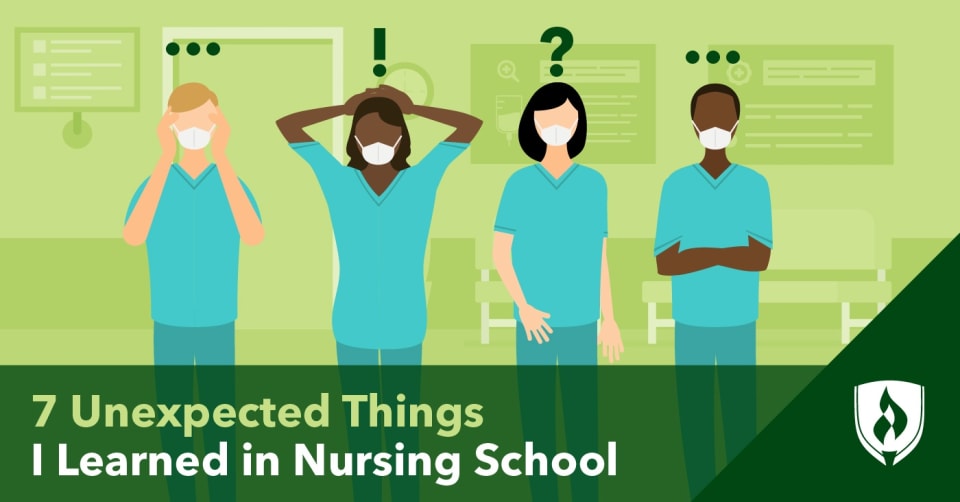
Students heading into nursing school likely have some expectations about the experience going in. It’ll be challenging. It can get stressful. It’s probably going to be a little gross. All of that naturally comes with the territory of preparing yourself for practically any healthcare career, and nursing school’s no different.
But if you talk to those on the other side of their nursing school experience, there’s plenty of unexpected things they learned along the way.
To get behind the scenes and look at what kinds of exciting, interesting and yes, sometimes weird, facts you’ll pick up on during your nursing school experience, we asked nurses from all stages in their careers to tell us their most memorable learning moments.
Get Your Nursing School Questions Answered at a Nursing Information Session
7 Surprising things I learned in nursing school
1. Don’t let waste…just go to waste
There’s nothing like starting off our number one takeaway with a bit of number two. The things nurses see coming through a clinic or hospital runs the gamut. From fungus to pus to feces, it’s often not very pretty, but time and experience help nurses become acclimated. Often times, these unpleasant things guide nurses in patient care.
“Poop is huge in making a nursing diagnosis,” explains Bobbie Russ, a registered nurse who works in long-term care. “Behaviors, colors, infections, smells, consistency: they all can tell you a lot.”
That’s right, there’s (hopefully figurative) gold to be found in patients’ bowel movements—so be prepared to get over any squeamishness quickly.
2. Don’t judge a book by its cover
Just because a patient looks healthy on the outside does not mean that everything is working like clockwork on the inside. Annette Lawton, an RN for nearly 40 years, recalls seeing a patient who was brought in because his friends thought maybe he wasn’t doing well but weren’t sure why. The answer came when Lawton and another nurse removed the patient’s boot, and his foot came off with it.
“That was my introduction to dry gangrene,” Lawton says.
Once past the initial shock of the moment, the team had to act quickly to prevent further damage. Ultimately, the patient’s leg had to be amputated as it had been only hanging on by a few tendons and a very tightly laced boot.
While the likelihood of encountering a circumstance as extreme as this during your time in nursing school is pretty low, there’s a lesson here: People are really adept at putting on a strong front even when going through immense pain. Good nurses are perceptive and can catch the little signs that something’s not quite right with a patient.
3. Wound care, a cornerstone of nursing
All nurses learn about Florence Nightingale, the British nurse and statistician who is considered by many to be the founder of modern nursing. Nightingale’s experiences of tending to wounded soldiers during the Crimean War helped guide and influence sanitation and nursing practices for decades to come.
The lessons of Nightingale and wound care came to the forefront for registered nurse Madelene Antrim. The first patient Antrim cared for as a nurse involved direct wound care for decubiti or bed sores.
“The patient had decubiti in some places as large as a dinner plate,” Antrim recalls. Many nurses were required to turn and position the patient so the wounds could be viewed and treated. Antrim held open the wound’s edges so the healing skin could be debrided. Though Antrim went into labor and delivery nursing, she was drawn to the idea of helping alleviate suffering so directly.
It might seem like a nurse from the era of the Crimean War is ancient history to students today, but there are still techniques from that time that have carried on and have since been improved upon.
“We’re using ancient techniques like leeches—though for different reasons—all the way to the use of wound vacuums for better in-to-out healing,” Antrim says.
4. Not all critical care is critical in the same way
When nursing student Charlotte Bay first got started in nursing, she knew that Intensive Care Units (ICU) and Emergency Rooms were both considered critical care. At first, Bay assumed both areas would require similar nursing approaches.
“I couldn’t have been more wrong,” Bay says. “In the ER, there is a consistent scrambling of various healthcare professionals and an incredibly diverse patient population. From broken arms, heart attacks, children with coughs, people with migraines--the list goes on. No matter 12pm or 3am, the ER is pretty consistently chaotic. The ICU is much calmer. The staff usually have a solid understanding of what is ‘wrong’ with the patient and always a detailed, uniform procedure of treatment.”
Both areas of the hospital are essential, but Bay learned that different units require different skill sets from their nurses.
5. The medical value of a sponge bath
On the topic of bed sores, also known as pressure ulcers, one of the best ways to avoid them entirely is to keep a patient’s body (and bedding) clean. Moving and turning a patient for these reasons helps relieve pressure on areas where bed sores are common, such as the spine, tailbone, shoulder blades, hips, heels and elbows.
“Moving a patient to wash them or change their bedding and clothing is another way to relieve that pressure,” Lawton says.
While bathing patients is likely not a highlight of a nurse’s potential daily duties, it’s important to remember that there’s real medical value in taking the time to do this.
6. Nursing is a team sport
As a nursing student, Bay has had the opportunity to work with COVID-19 patients, both in Intensive Care and the general unit. Because COVID-19 patients’ lungs are under stress, putting them on their stomach makes it easier for them to breathe.
“Our lungs actually sit closer to our back than our chest,” Bay explains. “So, it’s easier for them to expand when we’re laying on our stomach.”
In the hospital, getting a patient on their stomach is called proning, a critical part of treatment for COVID-19 patients. This procedure—and many, many others common in nursing care--often requires more than one nurse.
“For patients who are intubated and sedated, there is a specific procedure that takes about five people to flip a person from their back to their stomach without breaking their neck or cutting off their airway,” Bay says.
It’s no secret that nursing is a physically demanding job. But having colleagues who have your back make taking care of people a whole lot easier. Of course, it’s not just physical tasks—nurses work as a team every day in their units to make sure patients’ needs are met.
7. Being a nurse is hard work, but it’s definitely worth it
People talk about the challenges of nursing for good reason. From time management to identifying the “most correct answer” in a given situation to learning how to work with new people, many who are in pain or feeling at their worst, nursing school and the profession overall comes with a lot of challenges.
But what makes this period of learning worth it is that in the end, you’ll be prepared for an in-demand career that helps heal and improve the lives of others. Not everyone can go in to work every day and do something truly meaningful—and that’s something to be proud of.
What will you discover?
What you’ll learn in nursing school goes beyond dosage formulas or the number of pints of blood in a human body. Each of these students and nurses cite continually learning new things as part of the draw for this career. While some of the learning moments might not be quite as memorable as the examples above, they do illustrate how growth as a nursing professional can come from where you’d least expect it.
Are you wondering about what it’s like to be a student nurse? If you think you have what it takes for this hands-on, ever-changing career and want to learn more about the nursing school experience, check out our article “How Hard Is Nursing School? Students Tell All.”
Related Articles:




